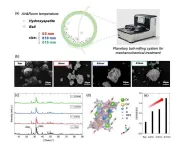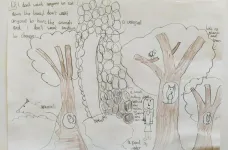Bone-deep: Mineral found in human bone can help fight toxic organic compounds
Hydroxyapatite, a mineral present in human bones, shows efficient decomposition of hazardous organic compounds when activated using mechanical stress
2021-05-11
(Press-News.org) One of the most prominent evils of rapid industrialization has been the emission of toxic pollutants into the surrounding biosphere, with often disastrous consequences for human beings. Several industrial processes, such as chemical manufacturing and printing, along with facilities such as power plants emit volatile organic compounds (VOCs) that are known to be cancer-causing and raise an important environmental issue in need of a solution. Traditionally, VOCs are controlled via a process called "catalytic oxidation," in which they are converted into benign materials in the presence of noble metal (e.g. gold, silver, and platinum) nanoparticles. However, the process is expensive and requires a fine-tuning of nanoparticle characteristics. Thus, a catalytic process not requiring noble metal catalysts is highly desirable. While transition metals and their oxides are a possible alternative, they require complex syntheses and precise chemical composition control.
So, can we do better than this? Turns out, we can! A team of scientists led by Prof. Takashi Shirai from Nagoya Institute of Technology (NITech), Japan, reported a complete catalytic decomposition of VOC using an inorganic compound called "hydroxyapatite" (HAp), a naturally occurring form of the mineral calcium phosphate that makes up most of the human bone structure. "HAp is made of elements abundant in nature, is non-toxic and exhibits high biocompatibility. Our results, thus, opened up a new possibility for designing cheap, noble-metal-free catalysts for VOC control," says Prof. Shirai.
In a new study published in Scientific Reports, Prof. Shirai and his colleague Yunzi Xin from NITech now take things further by tailoring the "active surface" of HAp using a mechanochemical treatment under ambient conditions that leads to a highly efficient catalytic oxidation of VOC with 100% conversion to harmless compounds! Specifically, they mixed initial HAp with ceramic balls in a vessel and conducted "planetary ball milling" at room temperature and ambient pressure. This essentially altered the chemical structure of HAp and allowed for its selective tailoring by simply changing the ball size.
By using different ball sizes (3, 10, and 15 mm) to systematically vary the morphology, crystallinity, surface defects/oxygen vacancy, acidity/basicity, and VOC affinity of HAps, the scientists carried out their characterization using various techniques such as scanning electron microscopy, powder X-ray diffraction, Fourier transform infrared spectrometry, X-ray photoelectron spectroscopy, electron spin resonance analysis, surface acidity/basicity evaluation, and gas-flowing diffuse reflectance infrared Fourier transform spectroscopy.
They observed a predominance of oxygen vacancy formation in the PO43- (triply charged PO4) site along with an enhanced basic site population caused by a selective mechanochemical activation of the c-plane (plane perpendicular to the symmetry axis) of the hexagonal HAp crystal and attributed it to the excellent catalytic conversion of VOC to CO2/CO.
Moreover, they found that HAps treated with 3 mm balls showed superior catalytic activity over that treated with 10- and 15-mm balls, even though larger balls caused more defects and basicity. By looking at the surface absorption of a VOC, ethyl acetate, scientists attributed this anomaly to the inhibited absorption of ethyl acetate in HAp treated with larger balls, leading to suppressed catalysis.
The results have excited scientists about the future prospects of HAps. "We expect that our catalyst will contribute significantly to VOC controlling and environmental cleaning all over the world by next decade, achieving the sustainable goals of clean air and water, affordable energy, and climate action," comments Prof. Shirai, excited.
Indeed, this is one huge step towards a more eco-friendly society!
INFORMATION:
[Attachments] See images for this press release:

ELSE PRESS RELEASES FROM THIS DATE:
2021-05-11
A new study from the University of Surrey has revealed 'real world' factors that influence people's interest in adopting a dietary pattern called time-restricted feeding.
According to NHS England, 67 per cent of men and 60 per cent of women in the UK are overweight or obese - with more than 11,000 yearly hospital admissions directly attributable to obesity.
Time-restricted feeding, which is a type of intermittent fasting, is the practice of restricting the time between the first and last food intake each day - therefore prolonging the daily fasting period.
In a study published by the ...
2021-05-11
A new study from the University of Portsmouth calls for further government oversight to curb potential illegal activity through these zones.
This study demonstrates the attractive trading advantages offered by freeports to enable enterprise and innovation. Eight new freeports in England are due to enter operation in late 2021, which are hoped to drive investment, economic opportunities and growth to those regions.
However, researchers also advise that stronger regulation is needed to prevent Freeports being abused for money-laundering and tax-evasion purposes. The study, ...
2021-05-11
Young children in deprived areas see nature and outdoor spaces as being associated with "happy places", according to a new study published in the journal Child Indicators Research.
Researchers Dr Nicola Walshe and Dr Zoe Moula from Anglia Ruskin University (ARU) asked 91 children aged seven and eight from two primary schools in areas of relatively high deprivation in the East of England to draw their happy place, before engaging them in group discussions about how they perceive their own wellbeing.
More than half of the children created drawings that included aspects of nature and outdoor spaces, such as trees, grass, parks, gardens, lakes, rivers, outdoor playgrounds, rainbows or sunlight. Trees, ...
2021-05-11
It was commonly assumed that wildlife products are exported from low-income countries to meet the demand of consumers in wealthy economies, and therefore, a widening wealth gap may drive up the volume of global trade and endanger wildlife.
Recently, a research team co-led by Research Division for Ecology and Biodiversity (E&B), Faculty of Science, the University of Hong Kong (HKU) and the Science Unit (SU) of Lingnan University (LU) corroborated this premise by analysing global wildlife trade databases. The research team includes Dr Jia Huan LIEW, Research Assistant Professor of SU, ...
2021-05-11
YouTube channels run by zoos focus on entertainment over education, according to a new study.
The videos also focus disproportionately on mammals, rather than reflecting the diversity of zoos' animals.
Conservation was the focus of just 3% of zoo videos in the study - but it found that conservation content in videos is gradually increasing.
The study evaluated the most recent and most-viewed videos, so the findings partly reflect the public's preference for certain species and content.
Of the animals that appeared in zoos' most-viewed videos, the top nine were mammals - with giant pandas ...
2021-05-11
Teamwork is becoming increasingly common in modern science. In this context, the effect of different characteristics of a team on its research performance has been studied extensively. Various factors such as team size, number of countries involved, universities, disciplines, and workload distribution have been found to have a significant contribution on the paper's role in advancing science.
The question of how the freshness of the team influences its research performance, however, has not been studied systematically. A research team may consist ...
2021-05-11
Most of us have imagined how free it would feel to float around, like an astronaut, in conditions of reduced gravity. But have you ever considered what the effects of reduced gravity might have on muscles? Gravity is a constant force on Earth which all living creatures have evolved to rely on and adapt to. Space exploration has brought about many scientific and technological advances, yet manned spaceflights come at a cost to astronauts, including reduced skeletal muscle mass and strength.
Conventional studies investigating the effects of reduced gravity on muscle mass and function have used a ground ...
2021-05-11
Duluth, Minnesota - A new paper in the May issue of Nature Communications demonstrates why keeping local lakes and other waterbodies clean produces cost-effective benefits locally and globally.
A single season of a lake or water body with a harmful algal bloom that results in public do-not-drink orders, damages to fishing activity, lost recreational opportunities, decreased property values and increased likelihood of low birth weight among infants born to mothers exposed to polluted water bodies are but just a handful of reasons why clean water is important.
Most everyone wants their local lake or stream to be clean and useable for drinking, fishing, swimming and recreation. But previous cost-benefit studies showed the costs ...
2021-05-11
LUND, Sweden--May 11, 2021--PolarCool AB (publ), a Swedish medical device company focusing on treatment of sports-related traumatic brain injury (TBI) and whiplash, today announced that it has submitted a 510(k) pre-market notification to the U.S. Food and Drug Administration (FDA) for the PolarCap® System.
This submission follows publication of statistically significant clinical results in the scientific journal Concussion, showing clear benefit for use of the PolarCap® System in the treatment of concussions among players of 15 elite Swedish Ice-Hockey teams in the Swedish Hockey Leagues (SHL).
The incidence of sports-related concussions is a significant national health ...
2021-05-11
Pregnant women who are hospitalized with COVID-19 and viral pneumonia are less likely than non-pregnant women to die from these infections, according to a new study by researchers with The University of Texas Health Science Center at Houston (UTHealth) and the University of Maryland School of Medicine (UMSOM).
The study was published today in Annals of Internal Medicine.
The study examined medical records from nearly 1,100 pregnant patients and more than 9,800 non-pregnant women ages 15 to 45 who were hospitalized with COVID-19 and pneumonia. Less than 1% of the pregnant patients died from COVID-19 compared to 3.5% of non-pregnant patients, according to the study findings.
Currently, the Centers ...
LAST 30 PRESS RELEASES:
[Press-News.org] Bone-deep: Mineral found in human bone can help fight toxic organic compounds
Hydroxyapatite, a mineral present in human bones, shows efficient decomposition of hazardous organic compounds when activated using mechanical stress




